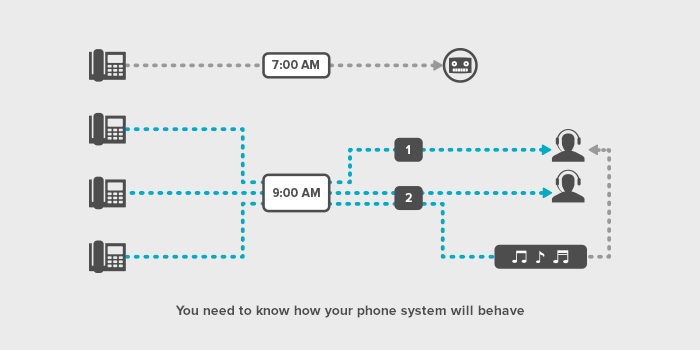Whether you’re installing a system or having one installed for you, if you don’t plan out your VoIP system features beforehand, you run the risk of creating an ongoing monster project that gives your budget gigantism and consumes all your time and your soul. Your provider, hardware, and platform structure are important, but you need to know how your phone system will behave to solidify your plan.
How you want your VoIP system to behave comes down to how you will be using it, and how you want the people calling in to use it. To figure that out, think about what you’re trying to achieve with your phone connection. Availability? Contact management? Branding? Once you’ve figured that out, use it to shape these features and you’ll be in a good spot to stop worrying about losing your soul.
Ring groups
Ring groups are the rules that tell calls where to go, making calls multiple phones ring when one number is called. Rules like, what happens if your receptionist doesn’t answer? Do calls ring to the next three people on the list all at once? Or one after another? And after how many rings? What happens when all of your customer service agents are busy? And so on. And you get the picture.
Setting up ring groups can feel like you’re building an seventeen-sided asymmetrical human pyramid. But if you remember to keep it simple, it shouldn’t be overwhelming. Keep thinking about how you want to use your VoIP system and it will be more clear. If live answers are important, find a way to get calls to a real person as quickly as possible.
Music on hold
This is kind of where branding comes in. Your PBX will probably have pre programmed hold music. Probably a couple of options. Have a listen to see if it’s appropriate for your company and audience or if that even matters. If you aren’t cool with the options you have available you can’t just throw up any old Zeppelin song (that’s an invitation for the copyright police to come take all your things) so if you want custom hold music, you’ll need to either create it or buy someone else’s.
Caller ID
Is it important for you to see Caller ID information on incoming calls? Not all VoIP providers deliver that info. So if you’ve picked out a VoIP provider that doesn’t provide CNAM lookups, you’ll need to incorporate a third party vendor that does.
Auto attendant
You are going to have conditions on your auto attendant. Usually time conditions. Like when you’re closed, calls will go straight to voicemail with a “we’re closed” message instead of ringing through to your receptionist. So figure out what those time conditions are and write down a schedule for them. Another scenario you’ll want to consider is what happens when your receptionist steps away and you want to maintain a live voice on your end. You will be able to create an away button for that, but where will it send calls? And where will calls go if the first backup destination is unavailable?
IVR Structure
Interactive Voice Response is the auto attendant system that moves calls around based on touch tone inputs or voice commands that navigate a list of options. Large consultancies have entire departments dedicated to building IVR answer trees. Planning yours can be intimidating, but there’s no getting around it. Start with language choice, then decide how you will categorize and distribute calls. What do the sub menus look like? And what information do you need for each department to answer calls as efficiently as they can?
All too often, IVRs make assumptions that block new customers from getting through, such as requiring all callers to enter their account number. Make sure your lists of options are inclusive while steering callers in a direction you can cover. And always include the option to speak to a live person.
It will help to draw a flowchart for call interactions so you know there are no paths that lead to a dead end. Dead ends lead to dead customer relationships. No one likes getting hung up on, especially after trudging through five layers of IVR.
Own your VoIP system
Customizing your system to your needs and your process will maximize your ROI, and the more customization as you can do up front, the better your transition experience will be. Of course it’s hard to know every use case you’ll need in advance. But planning out features before you set them up will save time, service calls, and productivity in the long run.







